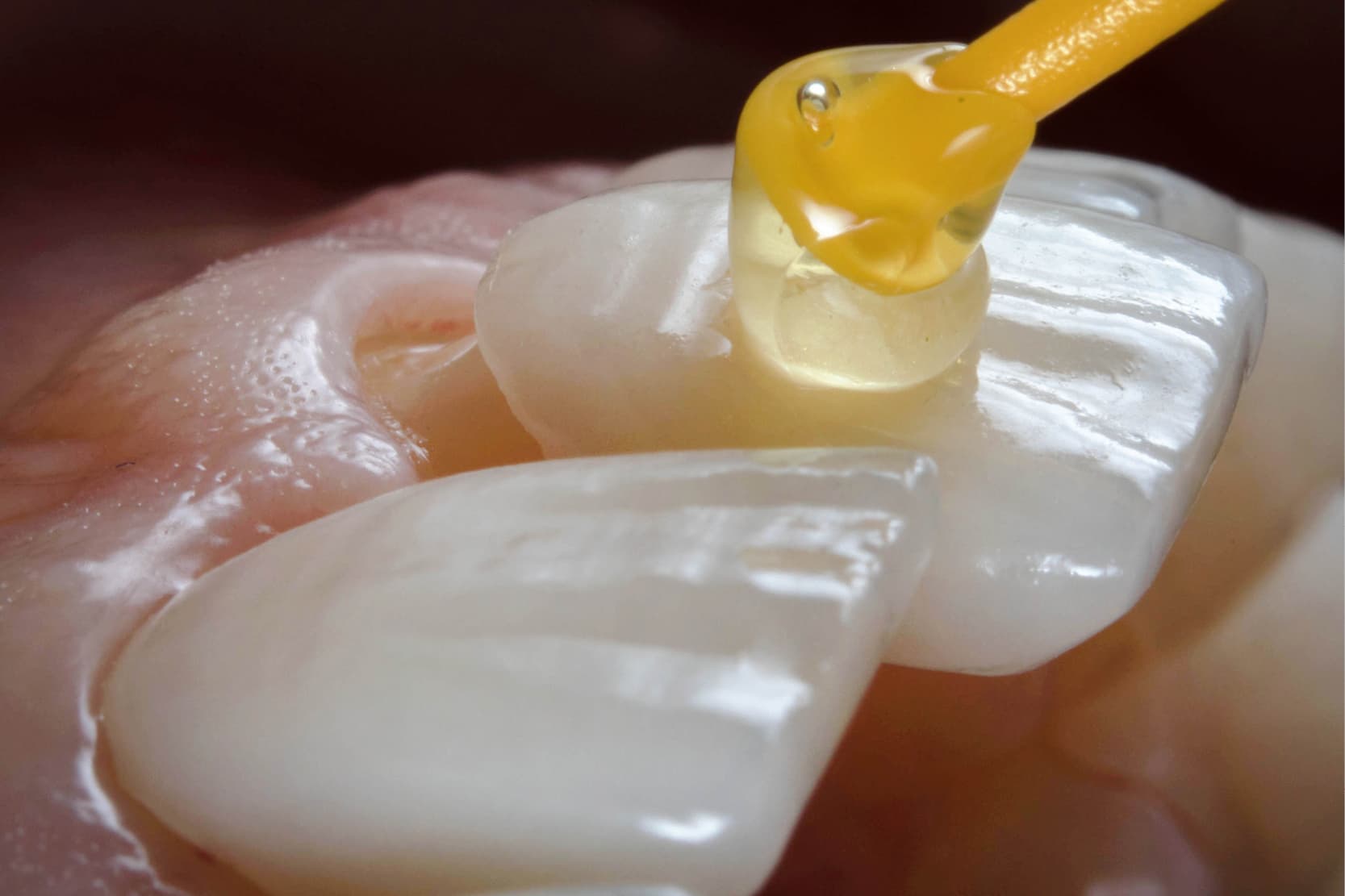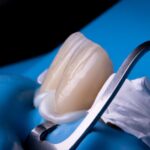
The clinical success of dental veneers depends on various factors, including proper cementing. (1)
As far as the materials and techniques for the preparation of dental veneers are concerned, they are usually fabricated using feldspathic ceramic or lithium disilicate, although zirconia and composite resin veneers have also recently been suggested. (2)
Ceramic naturally has a certain degree of frailty, i.e. it is unable to withstand stresses that cause significant deformations. Adhesive cementing, that is therefore able to penetrate the roughness and irregularities of the inner surface, can improve the fracture strength of veneers, by minimising fracture propagation, and making transfer of the stress from the restoration to the residual tooth structure more effective. (3)
How to cement dental veneers
1) Using try-in paste
Before the actual cementing step, veneers must be tried-in.
Both the patient and the dentist must be satisfied with the aesthetic result. It is also necessary to check:
- the precision of the preparation margin;
- the proper location of the point of contact;
- the contacts in maximum intercuspation, protrusion and laterality.
This step can be carried out using a “try-in paste” , with a colour similar to the definitive luting cement to be used. (4) This try-in is of paramount importance, because the colour of the luting cement that will be used for cementing can affect the final colour and therefore the aesthetic value and biomimetics of the veneer. (5)
Once the work has been accepted from all perspectives by the dentist and patient, the actual cementing process may begin.
2) Pretreatment of the inner surface
The first step of cementing is the proper preparation of the inner surface of the veneer to be cemented. As the various materials have different physical and chemical characteristics, they must be pretreated in a completely different manner.
The purpose of pretreatment is to make the inner surface of the veneer fit for a bonding procedure. As the main aim of these treatments is to make the surface rough on a microscopic level, they must not be carried out on the vestibular surfaces, which must remain perfectly polished.
Glass-matrix ceramics like lithium disilicate and feldspathic ceramic must be pretreated by etching with hydrofluoric acid, which is able to dissolve the glass matrix and expose the crystalline structure. (6) Once etching is complete, a coupling agent, such as silane, is applied to bind the organic components with the inorganic ones, to create a chemical bond between the composite resins and the inorganic glass matrices. (7)
Zirconia, on the other hand, cannot be etched, because it is not vitreous. The most effective pre-treatment for zirconia appears to be the tribochemical technique involving sandblasting with silica-coated aluminium particles at a pressure of 1.8-2.8 bar (8) and subsequently, the use of a primer containing the monomer MDP would appear to be effective. (9)
For composite veneers, on the other hand, it would appear advisable to carry out sandblasting with aluminium oxide. (10)
3) Isolation and etching techniques
Then, as in any bonding procedure, it is essential to ensure the proper isolation of the field from any potential saliva and gingival crevicular fluid contamination. Therefore, when possible, absolute isolation of the field should be carried out using a rubber dam. (11.12)
Once the teeth have been isolated, it is possible to perform etching. This is usually done using 35% phosphoric acid. (13) After this, depending on the bonding technique chosen, the primer and bonding agent are applied and, once the bonding agent has been evenly distributed using a jet of air, it is cured. Usually, the bonding agent is applied to the surface of both the tooth and the veneer.
4) Positioning the resin-based luting cement inside the veneer
The last step is to position the resin-based luting cement of the chosen colour inside the veneer. The veneer is positioned by applying light pressure, watching the excess luting cement ooze from the preparation margin.
The resin-based luting cements developed specifically for veneers are generally light-curing or dual and have a density that is somewhere between that of a flowable composite and that of a heated composite. (14) This is because, working with extremely limited thicknesses, it is not possible to apply significant forces, as this could fracture the veneer.
A resin-based luting cement specifically for use with veneers must ensure passive veneer positioning, allow long working times, be stable and free of air bubbles, offer good mechanical properties and permit easy removal of any excess due to its density. (14)
5) Final curing
Once the position and proper fit of the veneer have been ascertained, and once the excess luting cement has been removed, it is possible to carry out final curing.
Bibliography:
- Soares, C. J., Soares, P. V., Pereira, J. C., & Fonseca, R. B. (2005). Surface treatment protocols in the cementation process of ceramic and laboratory‐processed composite restorations: a literature review. Journal of esthetic and restorative dentistry, 17(4), 224-235.
- Ravinthar, K. (2018). Recent advancements in laminates and veneers in dentistry. Research Journal of Pharmacy and Technology, 11(2), 785-787.
- Moraes RR, Correr-Sobrinho L, Sinhoreti MA, Puppin-Rontani RM, Ogliari F, Piva E. Light-activation of resin cement trough ceramic: relationship between irradiance intensity and bond strength to dentin. J Biomed Mat Res. 2008;85B:160–165.
- Vaz, E. C., Vaz, M. M., de Torres, É. M., de Souza, J. B., Barata, T. D. J. E., & Lopes, L. G. (2019). Resin Cement: Correspondence with Try‐In Paste and Influence on the Immediate Final Color of Veneers. Journal of Prosthodontics, 28(1), e74-e81.
- Wang, Y. N. (2015). The influence of resin cements on the final color of ceramic veneers. Journal of prosthodontic research, 59(3), 172-177.
- Zogheib, L. V., Bona, A. D., Kimpara, E. T., & Mccabe, J. F. (2011). Effect of hydrofluoric acid etching duration on the roughness and flexural strength of a lithium disilicate-based glass ceramic. Brazilian dental journal, 22, 45-50.
- Anagnostopoulos, T., Eliades, G., & Palaghias, G. (1993). Composition, reactivity and surface interactions of three dental silane primers. Dental Materials, 9(3), 182-190.
- Comino-Garayoa, R., Peláez, J., Tobar, C., Rodríguez, V., & Suárez, M. J. (2021). Adhesion to Zirconia: A systematic review of surface pretreatments and resin cements. Materials, 14(11), 2751.
- de Souza, G., Hennig, D., Aggarwal, A., & Tam, L. E. (2014). The use of MDP-based materials for bonding to zirconia. The Journal of prosthetic dentistry, 112(4), 895-902.
- D’Arcangelo, C., Vanini, L., Casinelli, M., Frascaria, M., De Angelis, F., Vadini, M., & D’Amario, M. (2015). Adhesive cementation of indirect composite inlays and onlays: A literature review. Compend Contin Educ Dent, 36(8), 570-7.
- Jurado, C. A., Fischer, N. G., Sayed, M. E., Villalobos-Tinoco, J., & Tsujimoto, A. (2021). Rubber Dam Isolation for Bonding Ceramic Veneers: A Five-Year Post-Insertion Clinical Report. Cureus, 13(12).
- Jurado, C., Watanabe, H., Tinoco, J. V., Valenzuela, H. U., Perez, G. G., & Tsujimoto, A. (2020). A conservative approach to ceramic veneers: a case report. Operative dentistry, 45(3), 229-234.
- Van Meerbeek, B., De Munck, J., Yoshida, Y., Inoue, S., Vargas, M., Vijay, P., … & Vanherle, G. (2003). Adhesion to enamel and dentin: current status and future challenges. OPERATIVE DENTISTRY-UNIVERSITY OF WASHINGTON-, 28(3), 215-235.
- https://www.styleitaliano.org/ceramic-veneer-cementation/
Do you want more information on Zhermack Dental products and solutions?
Contact us




 Zhermack SpA has been one of the most important producers and international distributors of alginates, gypsums and silicone compounds for the dental sector for over 40 years. It has also developed solutions for the industrial and wellbeing sectors.
Zhermack SpA - Via Bovazecchino, 100 - 45021 Badia Polesine (RO), Italy.
Zhermack SpA has been one of the most important producers and international distributors of alginates, gypsums and silicone compounds for the dental sector for over 40 years. It has also developed solutions for the industrial and wellbeing sectors.
Zhermack SpA - Via Bovazecchino, 100 - 45021 Badia Polesine (RO), Italy.


